Search Results
BART to operate Sunday service on Memorial Day
On Monday, May 30, Memorial Day, BART will operate on a regular Sunday schedule. Trains will operate beginning at 8 a.m. at 20-minute intervals on the three lines listed below. Richmond to Fremont Pittsburg/Bay Point to Millbrae Dublin/Pleasanton to Daly City
Role in the Region: BART is critical to the economy
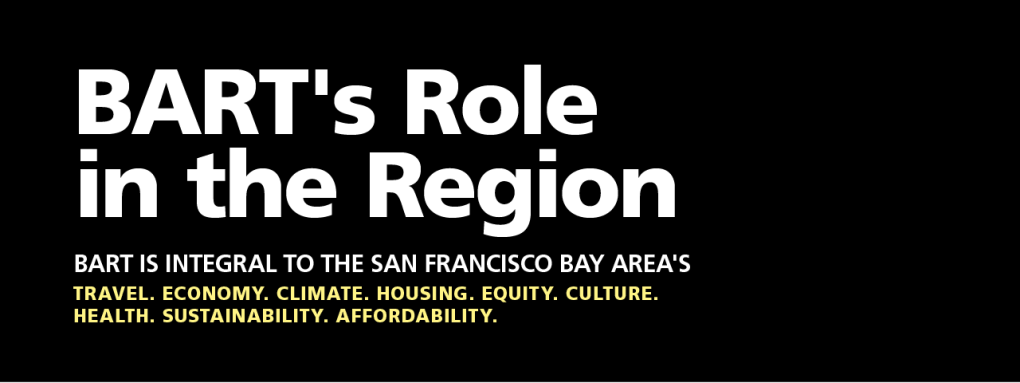
In July, BART released the Role in the Region Report, a comprehensive study of BART's impact on the Bay Area illustrated by new analyses, data visualizations, and powerful personal narratives. Over the coming weeks, we'll be sharing some of the key insights from the report in a series of Role in the Region articles here on bart.gov. Read the first article here. We encourage you to read the full report - click here - and visit the project webpage at bart.gov/roleintheregion.
Today's post examines BART's impact on the regional economy. See the full report for methodology.
Fueled by unparalleled venture capital funding, a resilient technology sector, and a growing cluster of artificial intelligence (AI) companies, the Bay Area economy remains hot. BART provides access to a region at the leading edge of technological innovation and economic investment. Since 2021, the Bay Area has regularly attracted at least 50 percent of the total venture capital investment in innovative sectors such as information technology.
San Francisco and the Peninsula
San Francisco continues to be a haven for innovative technology-focused businesses, and many firms cluster in BART-adjacent neighborhoods like South of Market and Hayes Valley.
Proximity to BART is a must-have for San Francisco’s downtown office market. Historically, office buildings near BART have outperformed non-BART accessible buildings based on market rents. Downtown San Francisco also has multiple “trophy” office buildings, which are commanding Downtown San Francisco’s highest rents and have the lowest vacancy rates. These buildings are all within a 15-minute walk of a BART station.
Top 15 San Francisco Office Buildings by Monthly Rent
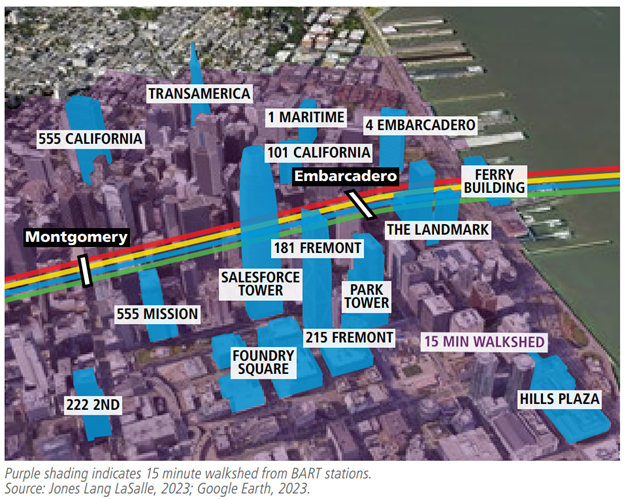
Along the Peninsula, mutual growth in development and BART ridership is expected. At Millbrae Station, the newly opened Gateway Transit Oriented Development has over 157,000 square feet of office space, ground floor retail, a 164-room hotel, and 400 residential units. At San Bruno Station, the Southline project is slated for occupancy by the end of 2024 and is made up of 2.8 million square feet of office and research and development space. The existing Tanforan Mall is also in the process of planning to transform into a transit-oriented mixed-use village with 2 million square feet of life science, 1,014 housing units, and 86,000 square feet of retail space.
The East Bay
The East Bay’s economy continues to uniquely leverage BART. Employment centers in the East Bay, which has the highest concentration of BART stations in the system, represent tremendous regional growth potential.
Emerging industries are choosing to locate in BART-served parts of the East Bay. These emerging industries include creative technology and design— like software publishing, data processing, and advanced manufacturing. In addition, there are emerging industry-specific job hubs for manufacturing in Fremont and wholesale trade in Union City. While most AI investment has gone to companies in San Francisco or the Peninsula, the East Bay has its own innovation industries, including biomedical device manufacturing, computer technology, food innovation, and clean tech. These industries and others have driven demand for almost one million square feet of R&D and manufacturing space in the last ten years and attracted $5.5 billion in venture capital in 2021.
East Bay Office Space Rent per Square Foot
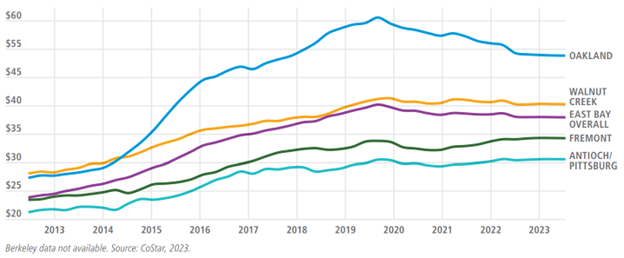
Many East Bay cities are responding to changing economic trends by adding jobs and housing. East Bay cities are leveraging access to BART to help shift market momentum towards their downtowns and prime infill locations. Demand and rents for East Bay commercial and industrial space remain high. Figure 2.9 shows that BART-served cities like Fremont and Walnut Creek continue to see increased rent for office space, and East Bay office rents have increased 59 percent overall since 2013. The East Bay industrial market continues to see high demand for warehouse and manufacturing space, with 11 consecutive quarters of net positive square footage leased as of 2023’s first quarter, with brokers and developers reporting an increased interest in transit accessibility for industrial tenants.
What BART Riders Say
When starting his own business, Raja Singh (pictured below with his son, Tyler) realized that transit would serve his employees’ well-being and morale. It also, as an added bonus, would serve his own interests and priorities as the head honcho.
"People perceive going into the office as somewhat of a burden, and I thought it was important to make it as easy as possible for folks,” he said. “It’s more relaxing to get on BART and zone out or work than it is to navigate a tunnel and bridge then find parking downtown.” Raja would know – he's been commuting by BART for well over a decade.
Raja also cited the recruitment benefits of headquartering his company by transit. They can enter the office, at 44 Montgomery Street, directly from the station, without having to step foot outside. Raja said nine of his employees live in the Bay Area and all of them commute by transit – seven take BART and two travel by Muni from their homes in the city.
“Because we’re located at a transit hub, we can recruit from the East Bay, the South Bay, the Peninsula, and the city all at once, and it’s equally easy to get there,” he said “There's nowhere else in the Bay where you can say that. It gives you the broadest recruiting reach.”
Read more about Raja here.
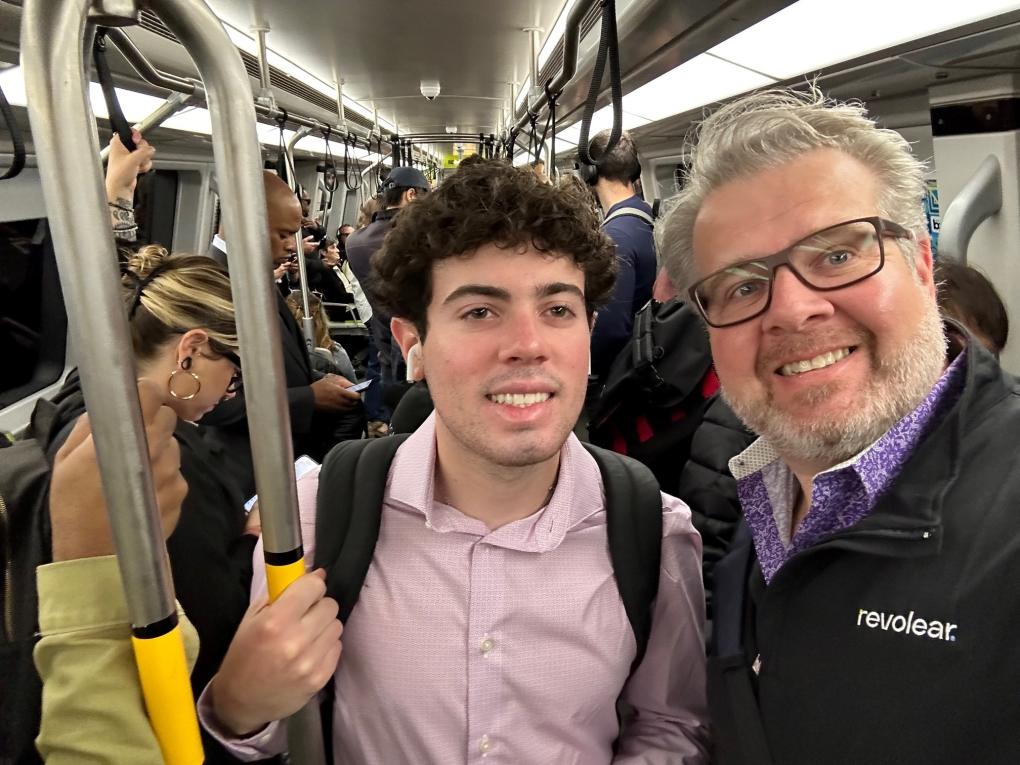
Celebrate Transit Month with BART this September

Ride transit, attend free events, win prizes, and connect with the community
This September marks the Bay Area’s tenth annual Transit Month. There are many opportunities to get on BART and celebrate the public transportation that keeps the Bay Area moving.
Hosted by San Francisco Transit Riders and Seamless Bay Area with support from local agencies, Transit Month toasts the many trains, buses, and ferries that connect the region and uplift its communities, economies, and cultures.
Transit Month is a great opportunity to explore the places transit can take you and to connect with local agencies and riders. The month is hallmarked by dozens of free events as well as a monthlong Ride Contest that invites participants to track their transit trips to win prizes, earn badges, and vie for top leaderboard positions. Last year, riders logged some 3,000 transit trips across every Bay Area agency. Sign up for the Ride Contest at ridecontest.com and start logging trips September 1.
BART’s hallmark event this year will be the Let’s Glow! BART Anime Festival on Saturday, September 6. Learn more about the celebration of art, anime, transit, and music here and RSVP (optional) at bartletsglow.eventbrite.com.
And be sure to mark your calendars for All Aboard Bay Area Transit Day on Tuesday, September 23, when we encourage the region to ride transit. BART staff will be riding trains and handing out stickers and surprising riders wearing the stickers with fun BART prizes.
Lastly, a virtual bonus: On the first day of Transit Month, September 1, BART will release the first of 12 YouTube videos of sped-up footage of the entire BART system – one line and one direction at a time. We’re calling it the BART Cab Cam, and every Monday for three months we’ll unveil a new video. Only Train Operators get to experience these views! Subscribe to BART’s YouTube channel to be alerted when a new video is posted.
Below, we’ve highlighted some of the month’s BART-centric events. Find the full event schedule at sftransitriders.org/transitmonth. Some programming is virtual.
Selection of Upcoming Transit Month Events
September 29 - October 5 -- National Week Without Driving
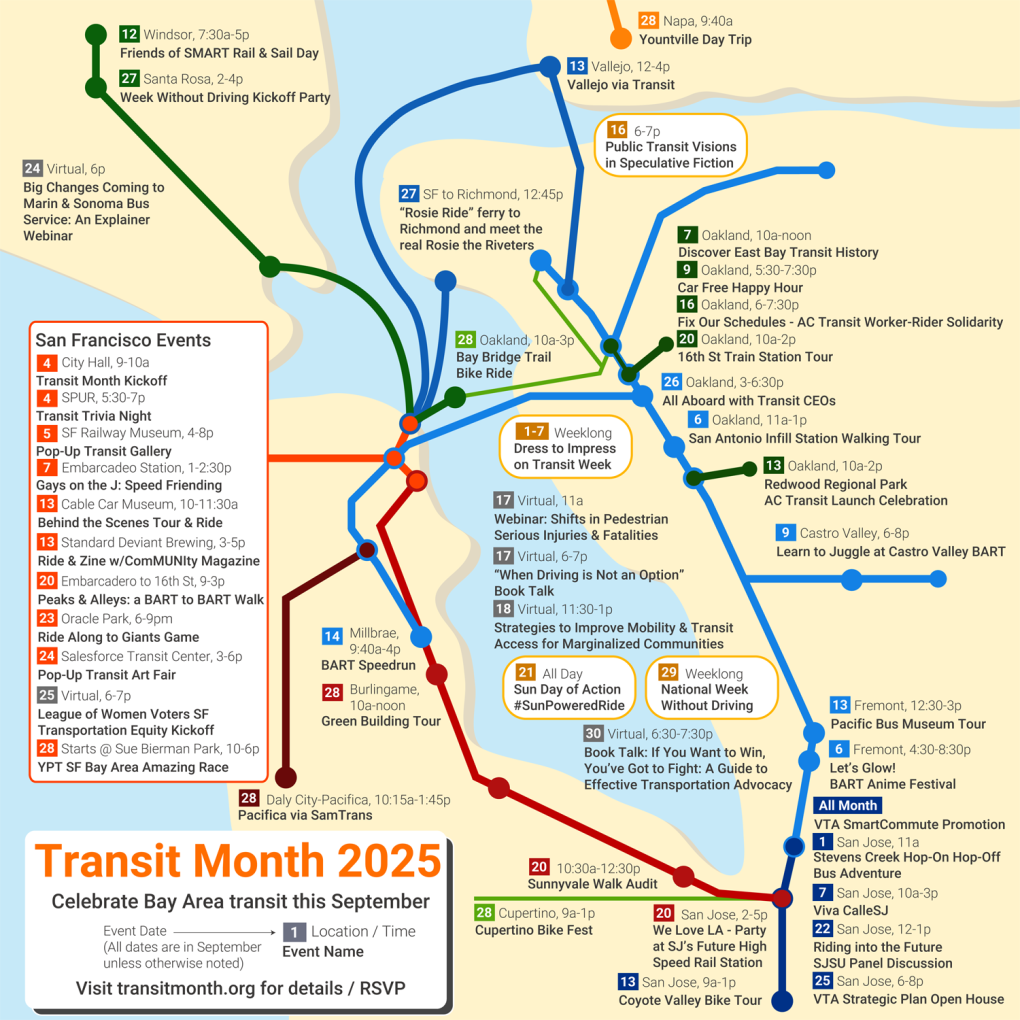
Past Events
September 1 - Fairyland’s Big Birthday Party Parade from 19th St. Station
September 1 - September 7, all day - Dress to Impress on Transit Week
September 4, 9am to 10am, SF City Hall (Civic Center) - Transit Month Kickoff Rally
September 4, 5:30pm to 7pm, SPUR Urban Center (Montgomery) - Transit Trivia Night
September 6, 4:30pm to 8pm, Warm Springs/South Fremont – Let's Glow! BART Anime Festival
September 6, 1pm to 5pm, Berryessa and Richmond – Books and BART Takeover with Silent Book Club Oakland
September 9, 6pm to 9pm, Castro Valley - Learn to Juggle at Castro Valley BART
September 12, 7:30pm to 11pm, 12th St. - East Bay Bike Party
September 14, 10am to 4pm, Millbrae – 53rd Anniversary BART Speedrun + Trivia
September 20, 9am to 3pm, Embarcadero – Peaks and Alleys: A BART to BART Walk
September 21, 11:15am, Hayward Station - Sunday in the Park Without Having to Park
September 23, all day – All Aboard Bay Area Transit Day
September 24, 3pm to 6pm, Salesforce Transit Center (Embarcadero) – Pop-up Transit Art Fair
September 26, 3pm to 6:30pm, 19th St./Oakland – All Aboard with Transit CEOs Ride-Along and Happy Hour, including BART GM Bob Powers
September 28, 10am to 3pm, MacArthur – Bay Bridge Trail Anniversary Ride
September 28, 10am to 6pm, Embarcadero – YPT SF Bay Area: Transit Month Amazing Race
BART sustains high ridership during Maze reconstruction
BART sets ridership records, weekday averages up BART carried an average of 9,274 more riders each weekday following the collapse of a portion of the MacArthur Maze on Sunday, April 29. Weekday ridership averaged 355,590 passengers from Monday, April 30 to Thursday, May 24. This was up from the 346,316 riders
Thousands attend BART’s 50th anniversary celebration
09.12.22 Posing for photos at BART’s 50th Anniversary Celebration and Family Fun Festival on Saturday, Sept. 10, 2022. At 8 am on Saturday morning, Lake Merritt Station and Plaza were already abuzz with activity. Train tracks – un-electrified third rail included – sprawled across a small section of the plaza
Violent and property crime plummet on BART
Newly released data shows crime has dropped substantially on BART through the first seven months of this year. The number of violent crimes reported on BART declined from 203 for the first seven months of 2024 to 130 incidents this year. Property crimes also fell from 1,091 for the first seven months of 2024 to 547 this year. All the latest crime numbers can be found in the July Chief’s Report.
The decrease in crime has come as BART PD has remained focused on maintaining a highly visible safety presence in the system. At the same time BART has accelerated the installation of Next Generation Fare Gates. Now 48 of BART’s 50 stations have new high-tech gates, which are proving to be a strong deterrent against fare evasion and other unwanted behavior. BART is well on track to meet its goal to have Next Generation Fare Gates at all stations by the end of this year. Maintaining a visible safety presence and installing new gates are both key components of BART’s Safe and Clean Plan to put the everyday concerns of riders first.
Other highlights from the Chief’s Report:
*Robberies plummeted from 126 for the first seven months of 2024 to 37 this year.
*Only one cellphone robbery was reported for the entire system in July. That follows zero cellphone robberies in June.
*Auto burglaries fell from 449 last year to 162 in 2025.
BART PD’s highly visible safety presence is making it possible for officers to get to incidents more quickly. The average emergency response time for July was 4 minutes, 21 seconds. That’s well below BART PD’s goal of five minutes and one of the fastest response times for any law enforcement agency in the Bay Area.
BART's continued response to the New Year's Day shooting
Frequently Asked Questions >> Sign up for "BART News Headlines" to receive email updates >> 11.17.09 BART Police Department Review Committee to meet Nov. 25 10.26.09 BART Police Department Review Committee to meet Nov. 4 09.30.09 BART Police Department Review Committee to meet Oct. 5 09.29.09 NOBLE presents
BART commits to a future powered by wind and solar power
BART took bold action today to improve the climate footprint of the Bay Area’s transportation sector. Following BART’s adoption of an aggressive and industry-leading Wholesale Electricity Portfolio Policy in April 2017, the BART Board of Directors today approved two 20-year renewable energy power purchase
Thousands attend BART’s 50th anniversary celebration
At 8 am on Saturday morning, Lake Merritt Station and Plaza were already abuzz with activity. Train tracks – un-electrified third rail included – sprawled across a small section of the plaza. An A-car nose (the pointy part at the front of the train) stood shining, awaiting the many selfies to come. And
Bus agencies increase price of BART Plus Ticket
Beginning July 1, 2009, bus agencies will increase the price of the BART Plus ticket. Because of the economic downturn affecting the participating BART Plus transit partners, the bus portion of the BART Plus ticket will increase $5.00 per period. There is no change to the stored BART value of the BART Plus